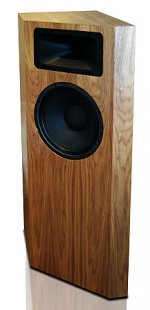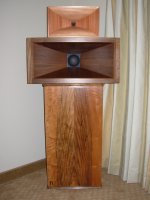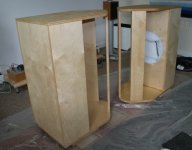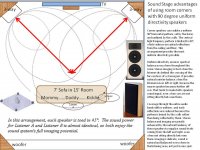You can get the benefits of "corner gain" and "90 degree controlled directivity" by constructing a corner cabinet for a standard front radiating speaker. (90degree radiation instead of 360degree radiation). Digital equalization can be used for both deep bass and room optimization.
A bass-horn will give additional gain, but with the trade-off of a reduced bandwidth. The Seven PI speaker is considered a good, simple construction bass-horn. Note the properly designed rear volume behind the woofer, and the direct radiation into the 90degree corner.
The newer Klipsch/DIY Jubilee bass corner horn measures better than the original Klipsch. Easier to build then the original, but still a nasty construction.
A bass-horn will give additional gain, but with the trade-off of a reduced bandwidth. The Seven PI speaker is considered a good, simple construction bass-horn. Note the properly designed rear volume behind the woofer, and the direct radiation into the 90degree corner.
The newer Klipsch/DIY Jubilee bass corner horn measures better than the original Klipsch. Easier to build then the original, but still a nasty construction.
Attachments
Corner horn systems like Klipsch seem so very complicated. Why couldn't it be as simple as two woofers on baffles open toward the corner as shown below (pardon the crude drawing) with a peice of MDF glued on top.
mike
There were some corner horns back in the '50s popularized by the Klipsch REBEL that were almost as simple.
I recall seeing patent applications that were variations of your design concept while looking for something else horn related, but at this late date I can't remember what I was searching for, though probably Tom Danley related in some way.
Is it possible to make this into a tall vertical array -- floor to ceiling, and reduce the necessary path length?
This would essentially be a column of drivers firing into the corner. Can anyone model this?
You can cheat some on mouth area, but path length needs to be 1/4 wave length of the lowest frequency. You can't cheat path length. That means 14 feet long for 20Hz, and 8 feet for 35Hz.
JLH,
let's say the target is 35Hz. But we place the column of woofers just one foot from the corner, firing into it. What will we get? Will the corner opening itself be a part of the "path length" or is it the mouth only and not helping to extend the path length?
Bottom line question is: there is not a way to shorten the horn path even with an array of woofers?
thank you,
Herman
let's say the target is 35Hz. But we place the column of woofers just one foot from the corner, firing into it. What will we get? Will the corner opening itself be a part of the "path length" or is it the mouth only and not helping to extend the path length?
Bottom line question is: there is not a way to shorten the horn path even with an array of woofers?
thank you,
Herman
You can cheat some on mouth area, but path length needs to be 1/4 wave length of the lowest frequency. You can't cheat path length. That means 14 feet long for 20Hz, and 8 feet for 35Hz.
Yea !!!!!!!!!!!!!!!!!!!!!
"My findings are that the 80hz horn works well at short listening distances like 8-12ft. The 85 hz hyperbolic horn is flat down to below 80hz and sounds best at listening distances 12-15ft. For a really large room, the 75hz horn goes down below 70Hz and requires at least a 20 ft listening distance......... As a rule of thumb you must be one wavelength away from a horn to be in the far field radiation zone for the best sound. For 100Hz, this distance is a little over 11ft."
(from Bruce Edgar)
High Efficiency Speaker Asylum
So, not only will it be a deep horn, but you need to be a bit away from it.
Norman
Herman,1)let's say the target is 35Hz. But we place the column of woofers just one foot from the corner, firing into it. What will we get?
2)Will the corner opening itself be a part of the "path length" or is it the mouth only and not helping to extend the path length?
3) there is not a way to shorten the horn path even with an array of woofers?
1) As JLH pointed out, you need around an 8 foot path length to achieve horn loading to 35 Hz. A column of woofers placed just one foot from the corner is basically just that a one foot horn with a parabolic expansion, it won't load at all in the sub frequency range, but will provide corner gain. Simply placing the woofers in a column in the corner would be roughly the same, but would not have the resonance induced by the stubby reflector.
2) In typical corner horns, the depth of the enclosure adds to the path length. In the case of a "horn" Mike drew in post #1, or what you are suggesting, the path length may be around 3 feet or so.
1130(speed of sound in feet per second)/3=376.66 Hz/4=94 Hz
3) The horn path can be shortened, but then the horn is not useful for sub frequencies.
Art
Norman," As a rule of thumb you must be one wavelength away from a horn to be in the far field radiation zone for the best sound. For 100Hz, this distance is a little over 11ft."
(from Bruce Edgar)
With all respect to Bruce that rule of thumb is as useless as an ashtray on a motorbike when it comes to horn subs, the "far field" is achieved in approximately the distance equivalent to the diameter of the mouth. Higher frequencies actually require longer distance to be in the far field.
There is an "integration distance" for multi-way separate horns, the larger the vertical spacing, the further away one needs to be, unless aligned for a specific near location.
Art
Norman,I found my Keele W-bin had no bass near it, but it hit you in the back of the room.
As also I've been in dance clubs with the bass horns on the edge of the dance floor. There was no bass until you got way off the dance floor.
Both examples you cite are demonstrations of room modes, which occur regardless of cabinet design. Believe me, after measuring dozens of subs of all different types outdoors, and using horn loaded subs on thousands of outdoor shows, the sound pressure is most intense the nearer you are to the horn mouth.
Here is a link to a site where the guy explores the Klipsch Rebel. Good read.
retro vintage modern hi-fi: Rebel
.
retro vintage modern hi-fi: Rebel
.
Olson (RCA)
Horns can sound like they have no bass right up close, this strange phenomenon can be heard when walking up to a mono Klipschorn with the HF disconnected.
Olson, section 1.5, Fig. 1.2, 1.3
Up close the phase angle between the pressure and the particle velocity in a spherical sound wave is 90°, this corrects itself at at a distance as it becomes a plane wave.
The charts show phase angle vs distance and particle velocity vs distance. Distance in both cases expressed as (2Pi/W)D, wavelength and distance assumed to be in feet.
For a 10° difference at 40hz it works out to like 22.5 feet.
For a 30° difference at 40hz it works out to like 8.2 feet.
The ratio of the absolute magnitude of the particle velocity to the pressure starts to flatten out beyond 8.2 feet for 40hz.
The very high losses at low frequencies would indicate that mic in the mouth is meaningless, but should be measured at a great distance and use inverse square to find the 1M spl (which is standard).
I've had people come up to me and tell me they couldn't hear anything coming out of a cabinet, it must be blown (yet it's pounding in the back of the room).
Horns can sound like they have no bass right up close, this strange phenomenon can be heard when walking up to a mono Klipschorn with the HF disconnected.
Olson, section 1.5, Fig. 1.2, 1.3
Up close the phase angle between the pressure and the particle velocity in a spherical sound wave is 90°, this corrects itself at at a distance as it becomes a plane wave.
The charts show phase angle vs distance and particle velocity vs distance. Distance in both cases expressed as (2Pi/W)D, wavelength and distance assumed to be in feet.
For a 10° difference at 40hz it works out to like 22.5 feet.
For a 30° difference at 40hz it works out to like 8.2 feet.
The ratio of the absolute magnitude of the particle velocity to the pressure starts to flatten out beyond 8.2 feet for 40hz.
The very high losses at low frequencies would indicate that mic in the mouth is meaningless, but should be measured at a great distance and use inverse square to find the 1M spl (which is standard).
I've had people come up to me and tell me they couldn't hear anything coming out of a cabinet, it must be blown (yet it's pounding in the back of the room).
Keep in mind that the purpose of a horn enclosure is to carefully, mathematically allow the waveform to expand and not be allowed to turn back on itself.Corner horn systems like Klipsch seem so very complicated. Why couldn't it be as simple as two woofers on baffles open toward the corner as shown below (pardon the crude drawing) with a peice of MDF glued on top.
mike
The horn is a 3 dimensional enclosure, yours is a two dimensional enclosure. You are sort of guiding the path in one direction, but neglecting the up and down dimension. The sound path should be allowed to grow exponentially. The other issue is that the two woofers will soon be out of phase without guidance and will cancel out.
- Status
- This old topic is closed. If you want to reopen this topic, contact a moderator using the "Report Post" button.
- Home
- Loudspeakers
- Subwoofers
- Why could corner horn not be this simple?




